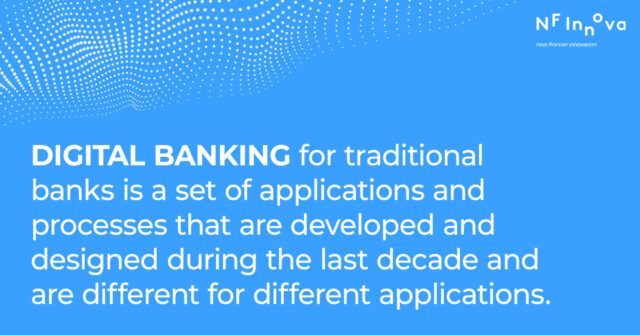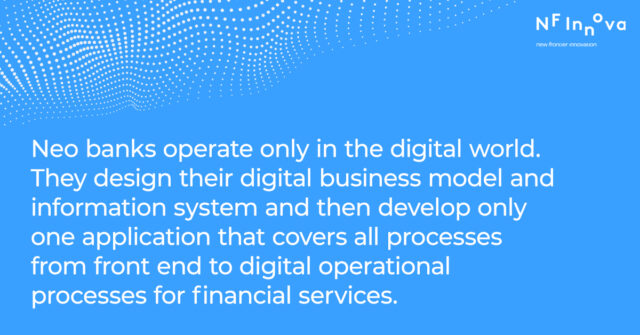Conclusion of the case studies in part 1 is that differences between traditional banks and neo banks are significant. The first difference is the speed of delivering requested financial services to clients (speed of banking operations), the second is clients’ effort and user experience necessary to finalize transaction in the banking application (design of the application) and the third is the cost of the complete financial service to clients (fees and charges).
What are the main reasons for these differences?
Banking information system (IS) is a very important part of operations of every bank. Tier 2 banks today have 100-300 applications in their IS and tier one banks up to 6.000. From the time they were first implemented to this day, these applications were adapted and changed many times. Traditional banks started introducing digital banking in the 1990s by implementing internet banking first and adding new applications as digital banking evolved. Some users still remember client – server solutions where one part of the application was on a PC and the other on a server, or SMS banking that is still in use in some parts of Africa. Starting from 2011 mobile banking using smart phones was introduced.

Today traditional banks offer separate applications for web retail banking, mobile retail banking, web private banking, mobile private banking, web corporate banking, mobile corporate banking, chat banking and conversational banking as standard. Some traditional banks require their clients to switch from one application to another or even to call customer center to finalize a requested financial service (see the case study in the blog part 1). For some financial services, traditional banks require clients to visit their offices (branches) one or even several times.
Digital banking for traditional banks consists of several very different applications separately designed and developed during the last 20 years. For same financial service operating processes are different for different channels. Applications only partially automate banking operational processes and seldom are making operational decisions. Clients are requested to enter data into digital copies of traditional, physical banking forms used 10 or 15 years ago. Operations are not automated and designed for digital world. To support clients in both worlds traditional banks have higher costs as they need to keep their tangible assets.

By definition, neo banks operate only in the digital world. They design their digital business model and information system and then develop only one application that covers all processes from front end to digital operational processes for financial services. Operation is automated ̶ software driven and designed for digital world. Physical and manual processes are converted, outsourced to partners, or used only if there is no other choice. They don’t need staff for operations. They cover all financial services processes: opening an account, transferring money to a private person, or paying an invoice from a company, taking a loan, or buying an insurance, changing the limit on the debit card or temporarily blocking it.
Clients are initiating processes, entering required data, and uploading documents, algorithms in the applications are checking, controlling, and making the decision to approve and execute the requested financial service or to reject it. Software is controlling ID documents several times faster and better than any human teller (comparing passport photo with the current photo of the client). Well-designed, software automated digital operation of banks is fast and low cost, simple and easy and clients are signing up because of the low cost for them (free), good user experience and speed. IS includes core banking or they use partners for banking as a service. It is all in the cloud with APIs to connect to third party solutions or to enable open banking. Neo banks have a serious advantage as they develop their new information system from scratch only for digital banking operation. If clients confirm that proposition has value for them by signing up, neo banks can grow and increase their market value.
Traditional banks are doing business in the combined physical and virtual world and neo banks are operating in the digital world. That’s were differences come from.
Traditional banks are still profitable, and they are counting on loyalty of their clients to stay profitable. High cost for clients (like in the case study about transferring 100 GBP to US) can be neglected by clients for a while, but if you combine results from all of Peter’s analyses about banking industry it is obvious that traditional banks have a real competition in neo banks. And with good reason.
Kodak already made a mistake as their board couldn’t make the decision to replace traditional photo business, generating 95 cents profit per invested dollar, with digital photography business that generates only 5 cents profit per invested dollar. Kodak’s board didn’t find the right talents to manage their digital business and as a result they announced insolvency after just a couple of years. We have the same situation with digital banks today: they aren’t ready to transform their operations to digital world and significantly reduce their profits by cutting fees and charges to be competitive in the digital world. They are still searching for talents among experts in traditional banking and can’t appoint digital talents to key positions.
Please let us know what you think: How do you see the differences between traditional banks and neo banks and fintech’s?

Branislav Vujovic
President of the Supervisory Board

